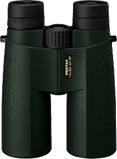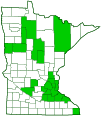Hexagonal-pored Polypore
(Neofavolus alveolaris)
Conservation • Description • Habitat • Ecology • Distribution • Taxonomy
Conservation Status |
|||
| IUCN Red List | not listed |
||
| NatureServe | not listed |
||
| Minnesota | not listed |
||
Description
Hexagonal-pored Polypore is an easily recognized, common, and widespread bracket fungus. It occurs in Europe, Japan, and North America east of the Rocky Mountains. In the United States it is especially common east of the Great Plains. It is one of the first mushrooms to appear in deciduous and mixed woodlands in the spring. It first appears in May, the same time as morels, and persists through November. It grows alone, scattered, or in small groups on recently fallen branches and small logs of hardwoods. It is saprobic, obtaining its nutrients from decaying wood and causing white rot.
The fruiting body is a semicircular to kidney-shaped, ⅜″ to 4″ wide, shelf-like bracket. When it first appears in late spring it is orange or orangish. It is at this stage that it is most easily recognized. The upper surface is dry, hairless, and covered with minute scales or delicate fibers (fibrillose). It is not concentrically zoned. As the season progresses the bracket fades to yellowish or nearly white.
It usually has a short, stubby stalk (stipe) but it may appear stalkless, and sometimes it has a more substantial stipe. The stipe, when present, is 3 ⁄16″ to ¾″ long and 1 ⁄16″ to 3 ⁄16″ thick. When stubby, it is positioned laterally. When substantial, it is positioned centrally and the cap is more or less round.
The pore surface is white to pale yellowish and is covered with conspicuous, large pores that are radially arranged in rows. The pores are up to 1 ⁄16″ (2 mm) long, up to 1 ⁄32″ (1 mm) wide, and diamond-shaped or six-sided. They are not all hexagonal, as the bracket’s common name suggests. The pore surface continues down the stalk.
Hexagonal-pored Polypore is not poisonous but the bracket is too small and the flesh is too tough to be edible.
Similar Species
Dryad’s Saddle (Cerioporus squamosus) is a much larger bracket with much larger scales and fibers.
Spring Polypore (Polyporus arcularius) is dark brown at first, becoming yellowish-brown as it ages. It always has a conspicuous, centrally positioned stalk.
Habitat and Hosts
Deciduous and mixed woodlands
Ecology
Season
May through November
Distribution |
||
|
Sources Biodiversity occurrence data published by: Minnesota Biodiversity Atlas (accessed through the Minnesota Biodiversity Atlas Portal, bellatlas.umn.edu, 11/9/2025). |
|
| 11/9/2025 | ||
Occurrence |
||
Common and widespread |
||
Taxonomy
Kingdom
Fungi (Fungi)
Subkingdom
Dikarya
Phylum
Basidiomycota (Basidiomycete Fungi)
Subphylum
Agaricomycotina (Higher Basidiomycetes)
Class
Agaricomycetes (Mushrooms, Bracket Fungi, Puffballs, and Allies)
Subclass
incertae sedis (uncertain placement)
Order
Polyporales (shelf fungi)
Family
Polyporaceae (bracket fungi)
Genus
Neofavolus
Genus
This fungus was originally named Merulius alveolaris in 1815. In 1941 it was moved to the genus Polyporus. In 2013, based on DNA and morphology, it was moved to the new genus Neofavolus. The name Neofavolus may be found invalid in the future, but it is the name most often used by authors today.
Subordinate Taxa
Synonyms
Boletus mori
Cantharellus alveolaris
Cantharellus alveolaris
Daedalea broussonetiae
Daedalea broussonetiae
Favolus canadensis
Favolus kauffmanii
Favolus mori
Favolus peponinus
Favolus striatulus
Favolus whetstonei
Hexagonia alveolaris
Hexagonia mori
Hexagonia mori
Hexagonia striatula
Merulius alveolaris
Polyporellus alveolaris
Polyporus alveolaris
Polyporus favoloides
Polyporus mori
Polyporus Tenuiparies
Common Names
Hexagonal-pored Polypore
Glossary
Saprobic
A term often used for saprotrophic fungi. Referring to fungi that obtain their nutrients from decayed organic matter.
Stipe
A supporting stalk-like structure lacking vascular tissue: in fungi, the stalk supporting the mushroom cap; in ferns, the stalk connecting the blade to the rhizome; in flowering plants, the stalk connecting the flower’s ovary to the receptacle; in orchids; the band connecting the pollina with the viscidium.
Visitor Photos
Share your photo of this fungus.
This button not working for you?
Simply email us at info@MinnesotaSeasons.com.
Attach one or more photos and, if you like, a caption.
Dan W. Andree |
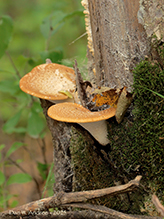 |
Mushrooms in the woods... Seen this one 9-28-25, it wasn’t very big maybe a couple inches or so across it top. |
MinnesotaSeasons.com Photos
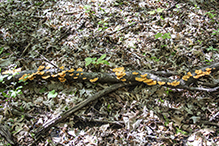 |
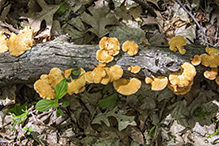 |
|
Habitat |
Habitat |
|
 |
 |
|
Habitat |
Habitat |
|
 |
 |
|
Habitat |
Cap |
|
 |
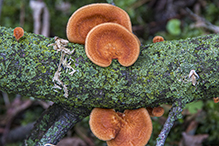 |
|
Cap |
Cap |
|
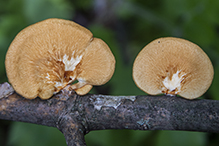 |
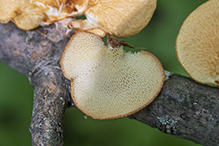 |
|
Cap |
Pore surface |
|
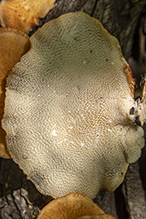 |
||
Pore surface |
|

Slideshows
Neofavolus alveolaris
Mushrooms Fungi
Polyporus alveolaris - fungi kingdom
Nineli Lishina
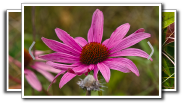
Visitor Videos
Share your video of this fungus.
This button not working for you?
Simply email us at info@MinnesotaSeasons.com.
Attach a video, a YouTube link, or a cloud storage link.
Other Videos
Hexagonal pored polypore, Neofavolus alveolaris, on a twig at Giant city state park.
Mike's thoughts on plants.
@ 36 - Hexagonal Polypore, Polyporus Alveolaris @ 1 - finally updated!
Glenn Munro
Polyporus alveolaris mushroom, the hexagonal pored polypore, and a sacred geometry pattern
Nature and consciousness
Neofavolus alveolaris, May 5, 2024
Грибы БАК - Mushrooms of the LHC

Visitor Sightings
Report a sighting of this fungus.
This button not working for you?
Simply email us at info@MinnesotaSeasons.com.
Be sure to include a location.
Dan W. Andree
9/11/2025
MinnesotaSeasons.com Sightings |
